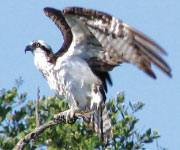 |
||||||||
Mariposa Key: Back from the Brink

Photos by Adam Gaylord
Several species of birds, including osprey, can be found at Mariposa Key.
To the average boater, Mariposa Key appeared to be an unspoiled paradise at the southwestern tip of Bishop Harbor. Accessible only by water, the six-acre island is ringed with a healthy border of mangroves and a lone Australian pine towering over native scrub oak.
That perception changed dramatically one Saturday last February when Damon Moore and Adam Gaylord, ecologists with Wilson Miller, decided to beach their kayaks and explore the interior of the island. Beyond the mangroves, they discovered stands of Brazilian pepper so dense they choked out all native vegetation and threatened to destroy one of Tampa Bay’s rare coastal berm habitats.
“It was at the tipping point,” Moore recalled. “If somebody hadn’t done something soon, the peppers would have taken over the entire island.”
They started by approaching management at the Tierra Ceia Preserve State Park, which owns the island but had no funds for restoration. Then Gaylord got a self-described hare-brained scheme – “let’s see if we can find some grant money and do it ourselves.”
With no experience in writing grants, they turned to co-workers at WilsonMiller who helped them obtain funding from the local chapter of the Florida Native Plant Society for a pilot project.
 The Sarasota and Tampa Bay Estuary Programs held a joint kayak trip to tour the partially restored island earlier this year.
The Sarasota and Tampa Bay Estuary Programs held a joint kayak trip to tour the partially restored island earlier this year.
“It looked really great from the shore, but it was definitely at risk,” notes Karen Fraley, naturalist for Around the Bend Nature Tours and an FNPS board member. “We were very impressed that these young men noticed what was going on and then stepped up to do something about it.”
Because Mariposa is accessible only by boat with the easiest approach at low tide, restoration was a “logistical nightmare,” but the FNPS grant helped them prove it could be done. Next step was the US Fish and Wildlife Service’s Coastal Program, a much more competitive arena with federal dollars available.
“It was a bumpy road but we came through it and got a $15,000 grant to go back in and get the rest of the peppers off the island,” Moore said. “We had a lot of help from people like Ann Hodgson at Florida Audubon to demonstrate the importance of the project.”
“It was at the tipping point,” Moore recalled. “If somebody hadn’t done something soon, the peppers would have taken over the entire island.”
Volunteers formed caravans of kayaks to help with the cleanup and plantings, but Wilson Miller's field crews were charged with the rough work. Heavy equipment was out of the question so huge stands of Brazilian pepper were cut down with just chain saws and machetes. Stumps were treated with herbicide but left intact to avoid soil disturbance.
With the island clear of invasive vegetation, Moore and Gaylord partnered with the Manatee-Sarasota Fish and Game Association to earn a $7,447 grant from the Tampa Bay Estuary Program to purchase native plants and continue the restoration. Planting is scheduled for this summer, once the rainy season begins, recognizing the inherent challenges of caring for newly installed plants on an island with no running water. The grant also calls for two years of maintenance and monitoring the restored areas to ensure that invasive plants don’t regrow.
“I think we’ve planned for enough maintenance to break the seed cycle,” Moore said. “An annual maintenance effort should control whatever washes up or is dropped by birds.”
Gaylord will be moving to Oregon to go back to school, but Moore is looking forward to his next restoration project. “There are a couple of places where I think we could make a difference – it’s been a wonderful experience and I hope I get to do it again.”
